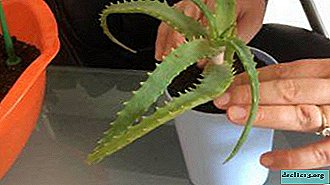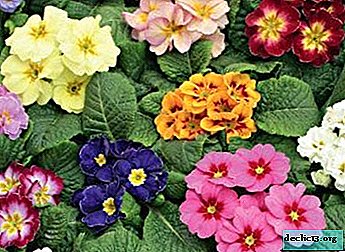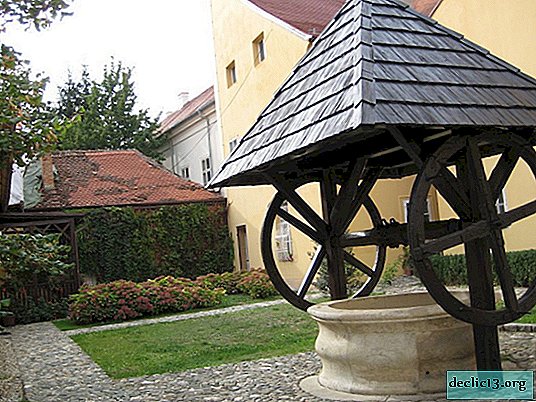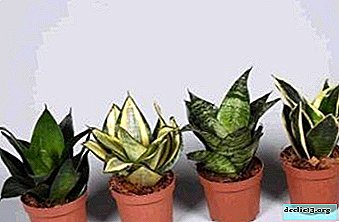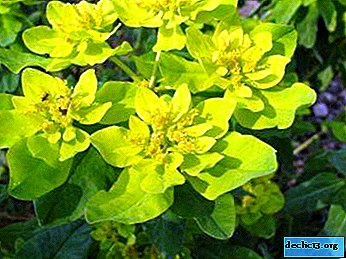Amazing orchid phalaenopsis Liodoro: photo, appearance and features
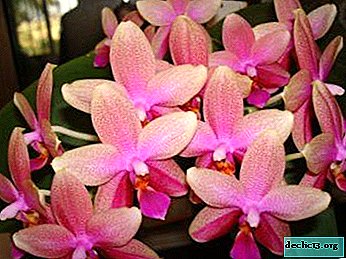
Now orchids are actively gaining momentum in their popularity. For flower growers, both professional and amateur, this type of plant always occupies a leading position. This is due to the unusual tenderness of the flowers. And her susceptibility to care is compared with royal vagaries.
It is all the more interesting to grow an orchid, proving to yourself that you can do this task too. Among the diverse palette of varieties of phalaenopsis, its appearance and beauty distinguishes such a species as Liodoro. It is precisely about her that we will tell in this article.
Brief botanical description and appearance
This species is a hybrid in origin.. It differs in a light green tint of the sheet plate, sometimes the pallor reaches yellow. Peduncles, like the whole plant, is characterized by large sizes.
An interesting feature of Liodoro can be called its alternate flowering, that is, the second phase of flowering will not begin until the first phase of this process is completed.This distinguishing feature makes it possible to extend the flowering period, and, therefore, the attractiveness of the culture.
For this feature, the people called this orchid "revolving." You can highlight another extraordinary feature of this type of phalaenopsis: its pleasant aroma, giving off sweet notes.
The color scheme of the buds is quite diverse: it starts with yellow and ends with deep pink, in rare cases - purple shades. Moreover, the intensity of the color itself directly depends on the care parameters provided by the owner of the plant. Often, flower stalks hang down under the weight of the buds.
Photo
Below you can find a photo of the phalaenopsis Liodoro.





History of occurrence
Some extensive data on the origin of this species of orchid is unknown. We only know that officially registered Liodoro in 1982.
Before the start of the 2000s, no one knew about this species except avid admirers of phalaenopsis.The history and description of the Liodoro orchid.
How is it different from other orchids?
We already wrote that Liodoro is a unique species due to its pleasant sweetish aroma. Moreover, in some gardeners the aroma is heard only in the mornings, in others - in the evening, and in others - even a whole day.
Also exceptional is the peduncle, which is constantly in an inclined position. (In other varieties, the peduncle is always erect).
Bloom
 It should be understood that not a single plant can delight others with its flowering all year round. But Liodoro boasts one of the longest flowering periods.. This is due to the phased opening of the buds. That is, until the first batch of flowers is completely reset, the second will not begin the flowering process.
It should be understood that not a single plant can delight others with its flowering all year round. But Liodoro boasts one of the longest flowering periods.. This is due to the phased opening of the buds. That is, until the first batch of flowers is completely reset, the second will not begin the flowering process.
The time of bud opening depends on the conditions created. This can happen in the fall, and in the spring, and even in the winter. Complex fertilizers will help prolong flowering and increase its abundance.
Features of care before and after
Caring for Liodoro before and after flowering time consists in the same rules and recommendations.
It should be remembered that it depends on the proper care of the milk after opening the buds how lush and long the next flowering will be.What should be watering?
Water needs to be prepared soft slightly warmer than room temperature. Moisturize the soil only during daylight hours and do it in such a way that water does not get into the plant’s outlet - such negligence can lead to rotting of rhizomes.
Also, flower growers recommend spraying the leaves of the culture.
Feeding rules
Unlike a blooming orchid, which is fed every ten to fifteen days, a non-flowering plant needs to be fertilized less often - about once a month.
Remember that high potassium fertilizers enhance flowering, and those that contain more nitrogen - are responsible for the growth of the green part of the plant. After flowering, be sure to prune the dried parts of the peduncle.
What if it does not happen?
To begin with, we note that after a flowering period, the orchid should rest a bit. This can last about a year. Also, do not worry if the baby does not open buds, since the dormancy period in young plants lasts up to two years. On the contrary, the early flowering of the baby will only aggravate the situation, because, maintaining the beauty of the flowers, the orchid is very weak. Therefore, these two cases are the norm.
There can be many reasons why Liodoro does not please his eyes with his beauty.
 Wrong Mode. The recommended difference between day and night temperatures should be more than five degrees. To ensure this condition, put a flowerpot with a flower at night in a cool place.
Wrong Mode. The recommended difference between day and night temperatures should be more than five degrees. To ensure this condition, put a flowerpot with a flower at night in a cool place.- Lighting. Orchid will not tolerate direct sunlight, as well as a lack of light. So the owners of this beauty will have to find a balance.
- Too much watering, and carrying out this procedure with cold water.
- Transfer. You have recently transplanted or pruned the roots of a plant. This is undoubted stress for him, so you have to wait for recovery within six months.
How to call?
- First way - the simplest: to provide optimal conditions for the existence of orchids.
- Second way - A sharp change in climate (but keep in mind that stress will push only a healthy plant to flowering, weakening will only harm).
- Third way - arrange drought by tritely reducing watering to a minimum.
- Fourth way - feed with chemical fertilizers or spray with the resulting solutions. (The most popular are Epin, succinic acid).
General care recommendations
Seat selection
Since the homeland of this plant is the tropics, it requires a well-lit place.
It is advisable to put a flower pot on the southern windowsill. Less commonly, to the southeast or southwest. In winter, Liodoro will most likely have to be provided with additional artificial lighting.
Never use lamps that heat up during incandescent light.
Soil and pot
The flowerpot should be transparent and smooth. The first factor in choosing a pot is due to the fact that the grower must constantly monitor the state of the root system. And the second is explained by the fact that the roots will grow into the rough surface of the pot.
 notice, that for beginning gardeners it is better not to risk with self-preparation of a soil mixture - buy a ready-made substrate.
notice, that for beginning gardeners it is better not to risk with self-preparation of a soil mixture - buy a ready-made substrate.
If you still decide to prepare the soil mix yourself. then for this you need:
- small pieces of bark;
- cork chips;
- sand (only coarse);
- moss;
- perlite or similar material.
Temperature
We already wrote that the temperature difference is extremely important for any orchid for normal growth.
At home phalaenopsis easily tolerates temperatures of 15 to 28 degrees above zero. It is desirable to precisely maintain this interval and not deviate from it in either one or the other direction.
Air humidity
Do not forget that orchids were brought to us from the tropics, where increased humidity is constantly preserved.
The humidity factor plays a big role in the life of orchids. Therefore, at home you will have to maintain such conditions.For this you can periodically spray the entire plant (both the flowering part and the green). And also install a container with water next to the flowerpots, which with its evaporation will raise the level of humidity around.
Lighting
There should be a lot of light. But he should not be scorching. Enough diffused ample lighting will suffice. Orchid requires a 12-hour light regime. If this cannot be done naturally, use artificial.
In the summer, it is recommended to shade the plants in any case. And in the fall, gradually open them to the light, gradually leading to a period of rest.
Watering
 Moist soil is suitable for this type of orchid. But keep in mind that in any case it is better to sometimes forget to moisten the gurunt than to water it too much.
Moist soil is suitable for this type of orchid. But keep in mind that in any case it is better to sometimes forget to moisten the gurunt than to water it too much.
In winter, with poor lighting and a low temperature, you can generally arrange a flower during a drought. Also be very careful with watering orchids after flowering - the same rule applies here: less is better, but better.
Only softened water is suitable for irrigation. Ideal option is melt or rainwater.
A signal for a new watering in the summer will be a dry 2-3-cm layer of soil.There are two optimal ways to moisten the soil: immersion or shower. In the first case, 10 minutes will be enough for the plant to be fed, in the second you need to let the water drain, and only then return the pot to its place.
Fertilizer
Liodoro needs additional nutrition only in the active phase of growth. Moreover, the frequency should not exceed once a week.
The concentration of fertilizer dilution specified on the packaging must not be increased. Also do not use nutritional complexes intended for other types of plants. You can do without fertilizers at all. To do this, update the soil at least once every two years.
Transfer
If you purchased an orchid in a store, then the first couple of years you should not need to transplant it. An exception may be the fact that the plant is planted in Sphagnum moss.
After transplanting, the flower asks for nothing but complete rest. A healthy plant adapts itself to new conditions and develops immunity.
Phalaenopsis Liodoro transplant.
Breeding
 Kids. Children are such new processes on the lateral shoots of orchids. If you notice a baby being formed, start spraying the entire flower as often as possible and wait until the new shoot takes root. After the roots appear, carefully cut the baby and put it in a separate pot. Do not forget to treat the places of cuts with powdered coal.
Kids. Children are such new processes on the lateral shoots of orchids. If you notice a baby being formed, start spraying the entire flower as often as possible and wait until the new shoot takes root. After the roots appear, carefully cut the baby and put it in a separate pot. Do not forget to treat the places of cuts with powdered coal.- Vegetative. For this type of reproduction, it is necessary to divide the roots of the plant into a couple of parts, while leaving at least two bulbs on each part. Again, be sure to sprinkle the places of cuts with wood ash and plant the segments in separate containers. Care for the cut rhizomes should be the same as for a regular orchid.
Diseases and Pests
- Rot. Orchid can undergo various types of rot (brown, gray, black, root). To combat it, it is necessary to remove the affected areas, and treat the remaining ones with fungicidal agents.
- Shield. Also, phalaenopsis can be attacked by a scab, which is characterized by the formation of pseudobulbs on a leaf plate. In order to heal Liodoro, collect all visible insects, treat the flower with Fitoverm and change the ground.
- Worm. These are fluffy white lumps that sit on the stems of culture. To combat the worm, remove it from parts of the plant with a damp cloth and treat it again with Fitoverm.
- Whitefly. And the last pest of Liodoro is whitefly. You can save a flower from death by wiping all its parts with a soapy solution, as well as treating it with Actellik.
Almost all orchid diseases are associated with improper care for it (this can be excessive watering, high humidity, and not changed soil in time).
If any signs of disease are found, first adjust the living conditions of the phalaenopsis. If this does not help, treat the flower with fungicides and change the soil.Problem prevention
To protect your beauty from ailments, crop care recommendations that are not so complicated. And it is advisable not to place flowerpots with orchids next to each other to prevent the transfer of diseases and pests from one flower to another.
Of course, there are many varieties of orchids that are very demanding to care for. But phalaenopsis Liodoro refers to this type, which will not be difficult to grow and a novice gardener.

 Wrong Mode. The recommended difference between day and night temperatures should be more than five degrees. To ensure this condition, put a flowerpot with a flower at night in a cool place.
Wrong Mode. The recommended difference between day and night temperatures should be more than five degrees. To ensure this condition, put a flowerpot with a flower at night in a cool place. Kids. Children are such new processes on the lateral shoots of orchids. If you notice a baby being formed, start spraying the entire flower as often as possible and wait until the new shoot takes root. After the roots appear, carefully cut the baby and put it in a separate pot. Do not forget to treat the places of cuts with powdered coal.
Kids. Children are such new processes on the lateral shoots of orchids. If you notice a baby being formed, start spraying the entire flower as often as possible and wait until the new shoot takes root. After the roots appear, carefully cut the baby and put it in a separate pot. Do not forget to treat the places of cuts with powdered coal.
